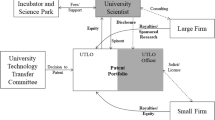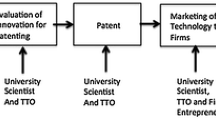Abstract
China possesses one of the largest university systems globally, and the focus of numerous previous studies has been on technology transfer from these universities. However, limited attention has been given to these aspects due to the absence of official data on spin-offs, technology transfer offices (TTOs), and research fields of universities. This paper aims to address this research gap by utilizing network DEA-Malmquist and Tobit models. The study specifically focuses on multiple-path of technology transfer, including patent sale and licensing, collaborative and contract research, and spin-offs. Furthermore, it measures the impact of various factors, including TTOs and research fields of universities, on efficiency. The findings are as follows: (1) The efficiency analysis reveals significant variations in the efficiency of the R&D stage and technology transfer stage among Chinese universities. The efficiency of the technology transfer stage is notably unsatisfactory. From 2011 to 2018, the efficiency of the R&D stage increased by 8.4%, while the efficiency of the technology transfer stage decreased by 3.5%. The overall efficiency witnessed a slight decline of 1.2%. (2) The Malmquist analysis demonstrates that 56.9% of universities experience efficiency growth in the R&D stage, whereas only 33% of universities exhibit efficiency growth in the technology transfer stage. The remaining universities either experience efficiency stagnation or a slight decline. (3) The analysis of influencing factors reveals that TTO capacity and the research fields significantly impact the technology transfer efficiency. This implies that it is crucial to consider not only the TTO but also the influence of the research fields of study on the efficiency and paths of technology transfer.





Similar content being viewed by others
Data Availability
The datasets generated during and/or analyzed during the current study are available from the corresponding author upon reasonable request.
Notes
It refers to a group of universities directly under the management of the Ministry of Education of the People’s Republic of China, with the aim of taking the first step in exploring reforms and playing a model role in improving teaching, scientific research and social services.
References
Abbott, M., & Doucouliagos, C. (2003). The efficiency of Australian universities: A data envelopment analysis. Economics of Education Review, 22(1), 89–97.
Abreu, M., & Grinevich, V. (2013). The nature of academic entrepreneurship in the UK: Widening the focus on entrepreneurial activities. Research Policy, 42(2), 408–422.
Anderson, T. R., Daim, T. U., & Lavoie, F. F. (2007). Measuring the efficiency of university technology transfer. Technovation, 27(5), 306–318.
Ang, S., & Chen, C. M. (2016). Pitfalls of decomposition weights in the additive multi-stage DEA model. Omega, 58, 139–153.
Beck, S., Bergenholtz, C., Bogers, M., Brasseur, T. M., Conradsen, M. L., Di Marco, D., ... & Xu, S. M. (2022). The Open Innovation in Science research field: A collaborative conceptualisation approach. Industry and Innovation, 29(2), 136–185.
Bertoletti, A., & Johnes, G. (2021). Efficiency in university-industry collaboration: An analysis of UK higher education institutions. Scientometrics, 126(9), 7679–7714.
Caldera, A., & Debande, O. (2010). Performance of Spanish universities in technology transfer: An empirical analysis. Research Policy, 39(9), 1160–1173.
Caves, D. W., Christensen, L. R., & Diewert, W. E. (1982). The economic theory of index numbers and the measurement of input, output, and productivity. Econometrica: Journal of the Econometric Society, 50(6), 1393–1414.
Chapple, W., Lockett, A., Siegel, D., & Wright, M. (2005). Assessing the relative performance of UK university technology transfer offices: Parametric and non-parametric evidence. Research Policy, 34(3), 369–384.
Charnes, A., Cooper, W. W., & Rhodes, E. (1978). Measuring the efficiency of decision making units. European Journal of Operational Research, 2(6), 429–444.
Chen, Y., Cook, W. D., Li, N., & Zhu, J. (2009). Additive efficiency decomposition in two-stage DEA. European Journal of Operational Research, 196(3), 1170–1176.
Chen, Z., Yang, Z., & Yang, L. (2023). Analyzing the knowledge transfer performance of China’s universities: A heterogeneous stochastic frontier approach. Journal of the Knowledge Economy, 1–29. https://doi.org/10.1007/s13132-023-01253-5
Curi, C., Daraio, C., & Llerena, P. (2012). University technology transfer: How (in) efficient are French universities? Cambridge Journal of Economics, 36(3), 629–654.
Curi, C., Daraio, C., & Llerena, P. (2015). The productivity of French technology transfer offices after government reforms. Applied Economics, 47(28), 3008–3019.
Despotis, D. K., Koronakos, G., & Sotiros, D. (2016). Composition versus decomposition in two-stage network DEA: A reverse approach. Journal of Productivity Analysis, 45, 71–87.
Faccin, K., De Beer, C., Martins, B. V., Zanandrea, G., Kela, N., & Schutte, C. (2022). What really matters for TTOs efficiency? An analysis of TTOs in developed and developing economies. The Journal of Technology Transfer, 47(4), 1135–1161.
Färe, R., Grosskopf, S., Norris, M., & Zhang, Z. (1994). Productivity growth, technical progress, and efficiency change in industrialized countries. The American Economic Review, 84(1), 66–83.
Friedman, J., & Silberman, J. (2003). University technology transfer: Do incentives, management, and location matter? The Journal of Technology Transfer, 28(1), 17–30.
Gao, Q., He, F., Moosa, A., & Lv, Q. (2019). The efficiency of technology transfer in Chinese key universities. Journal of Scientific and Industrial Research, 78(9), 582–588.
Gong, L., Liu, Z., Zhang, S., & Jiang, Z. (2022). Does open innovation promote innovation efficiency in Chinese universities? IEEE Transactions on Engineering Management. https://doi.org/10.1109/TEM.2021.3140116
Guo, C., Shureshjani, R. A., Foroughi, A. A., & Zhu, J. (2017). Decomposition weights and overall efficiency in two-stage additive network DEA. European Journal of Operational Research, 257(3), 896–906.
Ho, M. H. C., Liu, J. S., Lu, W. M., & Huang, C. C. (2014). A new perspective to explore the technology transfer efficiencies in US universities. The Journal of Technology Transfer, 39, 247–275.
Hou, B., Hong, J., & Shi, X. (2021). Efficiency of university–industry collaboration and its determinants: Evidence from Chinese leading universities. Industry and Innovation, 28(4), 456–485.
Hou, B., Tang, X., Zhang, Y., Hong, J., & Wang, S. (2023). University-industry cooperation and regional economic convergence: The moderating role of intellectual property protection. Journal of the Knowledge Economy, 14(3), 3327–3352.
Hülsbeck, M., Lehmann, E. E., & Starnecker, A. (2013). Performance of technology transfer offices in Germany. The Journal of Technology Transfer, 38, 199–215.
Ito, T., Kaneta, T., & Sundstrom, S. (2015). Does university entrepreneurship work in Japan?: A comparison of industry-university research funding and technology transfer activities between the UK and Japan. Journal of Innovation and Entrepreneurship, 5(1), 1–21.
Kao, C., & Hwang, S. N. (2008). Efficiency decomposition in two-stage data envelopment analysis: An application to non-life insurance companies in Taiwan. European Journal of Operational Research, 185(1), 418–429.
Kim, Y. (2013). The ivory tower approach to entrepreneurial linkage: Productivity changes in university technology transfer. The Journal of Technology Transfer, 38, 180–197.
Kirby, D. A., & El Hadidi, H. H. (2019). University technology transfer efficiency in a factor driven economy: The need for a coherent policy in Egypt. The Journal of Technology Transfer, 44, 1367–1395.
Lafuente, E., & Berbegal-Mirabent, J. (2019). Assessing the productivity of technology transfer offices: An analysis of the relevance of aspiration performance and portfolio complexity. The Journal of Technology Transfer, 44(3), 778–801.
Lee, K., & Jung, H. J. (2021). Does TTO capability matter in commercializing university technology? Evidence from longitudinal data in South Korea. Research Policy, 50(1), 104133.
Lee, H. H., & Tan, H. B. (2006). Technology transfer, FDI and economic growth in the ASEAN region. Journal of the Asia Pacific Economy, 11(4), 394–410.
Li, D., & Fu, X. (2021). The efficiency of university technology transfer in China. Asian Economic Papers, 20(3), 114–137.
Ma, D., Cai, Z., & Zhu, C. (2022). Technology transfer efficiency of universities in China: A three-stage framework based on the dynamic network slacks-based measurement model. Technology in Society, 70, 102031.
Malmquist, S. (1953). Index numbers and indifference surfaces. Trabajos De Estatistica, 4, 209–242.
Miranda, F. J., Chamorro-Mera, A., & Rubio, S. (2017). Academic entrepreneurship in Spanish universities: An analysis of the determinants of entrepreneurial intention. European Research on Management and Business Economics, 23(2), 113–122.
Muscio, A. (2010). What drives the university use of technology transfer offices? Evidence from Italy. The Journal of Technology Transfer, 35, 181–202.
Osabutey, E. L., & Jackson, T. (2019). The impact on development of technology and knowledge transfer in Chinese MNEs in sub-Saharan Africa: The Ghanaian case. Technological Forecasting and Social Change, 148, 119725.
Perkmann, M., Salandra, R., Tartari, V., McKelvey, M., & Hughes, A. (2021). Academic engagement: A review of the literature 2011–2019. Research Policy, 50(1), 104114.
Pronay, S., Keszey, T., Buzás, N., Sakai, T., & Inai, K. (2022). Performance of university technology transfer offices: evidence from Europe and Japan. International Journal of Productivity and Performance Management, 71(4), 1343–1364.
Scarrà, D., & Piccaluga, A. (2022). The impact of technology transfer and knowledge spillover from Big Science: A literature review. Technovation, 116, 102165.
Seiford, L. M., & Zhu, J. (1999). Profitability and marketability of the top 55 US commercial banks. Management Science, 45(9), 1270–1288.
Siegel, D. S., Waldman, D., & Link, A. (2003). Assessing the impact of organizational practices on the relative productivity of university technology transfer offices: An exploratory study. Research Policy, 32(1), 27–48.
Siegel, D., Wright, M., Chapple, W., & Lockett, A. (2008). Assessing the relative performance of university technology transfer in the US and UK: A stochastic distance function approach. Econ. Innov. New Techn., 17(7–8), 717–729.
Thursby, J. G., & Kemp, S. (2002). Growth and productive efficiency of university intellectual property licensing. Research Policy, 31(1), 109–124.
Thursby, J. G., & Thursby, M. C. (2002). Who is selling the ivory tower? Sources of growth in university licensing. Management Science, 48(1), 90–104.
Tobin, J. (1958). Estimation of relationships for limited dependent variables. Econometrica: Journal of the Econometric Society, 26(1), 24–36.
Vinig, T., & Lips, D. (2015). Measuring the performance of university technology transfer using meta data approach: The case of Dutch universities. The Journal of Technology Transfer, 40, 1034–1049.
Wang, D. D. (2019). Performance-based resource allocation for higher education institutions in China. Socio-Economic Planning Sciences, 65, 66–75.
Wang, J., & Zhao, M. (2022). Evaluation of regional university technology transfer performance in China based on super-efficiency SBM. International Journal of Technology Management, 90(1–2), 54–77.
Yang, Z., Wang, D., Du, T., Zhang, A., & Zhou, Y. (2018). Total-factor energy efficiency in China’s agricultural sector: Trends, disparities and potentials. Energies, 11(4), 853.
Zhu, C., Li, X., & Chen, Y. (2021). Did the Chinese Bayh-Dole Act encourage the activities of technology transfer? An answer from a legal system. Asian Journal of Technology Innovation, 29(2), 196–212.
Acknowledgements
We appreciate the reviewers for their insightful suggestions.
Funding
This work was financially supported by the Natural Science Foundation of Xinjiang Uygur Autonomous Region (Grant No. 2023D01C28), the Ph.D. Scientific research Start-up Project of Xinjiang University (Grant No. BS202104), the Tianchi Doctoral Project of Xinjiang (Grant No. TCBS202050), the Xinjiang High-level Talents Tianchi Program (Grant No. TCBR202104), and the National Natural Science Foundation Project (Grant No. 72071196).
Author information
Authors and Affiliations
Contributions
Kun Chen (First Author): conceptualization, methodology, investigation, formal analysis, writing—original draft. Abduhalik Wupur (Corresponding Author): data curation, formal analysis, writing—original draft, writing—review and editing. Xu Liu: data curation, writing—review and editing. Guo-liang Yang: supervision, conceptualization, methodology, review and editing.
Corresponding author
Ethics declarations
Conflict of Interest
The authors declare no competing interests.
Additional information
Publisher's Note
Springer Nature remains neutral with regard to jurisdictional claims in published maps and institutional affiliations.
This article is part of the Topical Collection on University and Entrepreneurial Ecosystems
Appendix
Appendix
Rights and permissions
Springer Nature or its licensor (e.g. a society or other partner) holds exclusive rights to this article under a publishing agreement with the author(s) or other rightsholder(s); author self-archiving of the accepted manuscript version of this article is solely governed by the terms of such publishing agreement and applicable law.
About this article
Cite this article
Chen, K., Wupur, A., Liu, X. et al. Measuring Multiple-Path Technology Transfer Efficiency in Chinese Universities: A Network DEA-Tobit Approach. J Knowl Econ (2024). https://doi.org/10.1007/s13132-024-01971-4
Received:
Accepted:
Published:
DOI: https://doi.org/10.1007/s13132-024-01971-4




